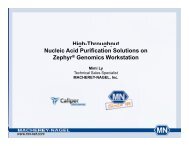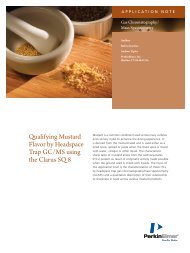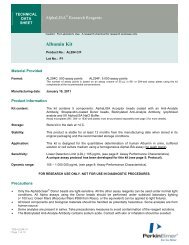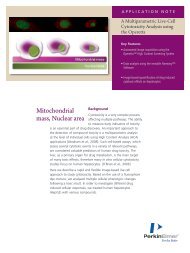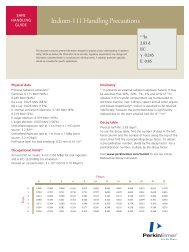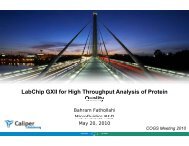Low Level Liquid Scintillation Counting of Radioactivity - PerkinElmer
Low Level Liquid Scintillation Counting of Radioactivity - PerkinElmer
Low Level Liquid Scintillation Counting of Radioactivity - PerkinElmer
You also want an ePaper? Increase the reach of your titles
YUMPU automatically turns print PDFs into web optimized ePapers that Google loves.
Cs-137<br />
Cs-137 can be monitored on the basis <strong>of</strong> its 662 keV gamma emission, which is actually from the metastable<br />
daughter Ba-137m. Actually Cs-137 first decays by beta emission, with 82 % probability through 500 keV beta<br />
emission into Ba-137m and with 8 % probability directly to Ba-137. Beta emission can be very well measured by<br />
liquid scintillation spectrometry. Identification <strong>of</strong> this isotope is further determined by the monoenergetic conversion<br />
electron peak at 625 keV.<br />
Sr-90/Y-90<br />
These isotopes have only beta decay mode and therefore liquid scintillation method is a very suitable one to use.<br />
Alpha counting<br />
Pulse shape analysis provides a means for alpha/beta separation on the basis <strong>of</strong> their different pulse lengths (shapes).<br />
Fluorescent decay <strong>of</strong> scintillation light is composed <strong>of</strong> prompt and delayed components; most <strong>of</strong> the light is<br />
produced in the prompt component. The amount <strong>of</strong> the light in the delayed component has long been known<br />
to be dependent on the particle or decay type: electrons originating from beta decay, gamma and X-rays are the<br />
predominant sources <strong>of</strong> prompt fluorescence, whereas alpha decay contributes more to the delayed component<br />
giving longer pulses than those produced by electrons. Beta particles are about ten times more effective in producing<br />
light than alpha particles. This is why the beta spectrum covers the alpha spectrum range in a scintillation counter<br />
although alpha particle energies are higher, typically 4 to 9 MeV.<br />
The Pulse Shape Analyser works by producing a PSA value, which relates the pulse length to the pulse amplitude.<br />
Thus the amplitude dependence <strong>of</strong> the pulse length is minimized. <strong>Counting</strong> <strong>of</strong> radon in water is a good example <strong>of</strong><br />
the application <strong>of</strong> the pulse shape analyser. Direct mixing <strong>of</strong> the sample is also in this case a sufficient method <strong>of</strong><br />
sample preparation.<br />
Rn-222 is a daughter <strong>of</strong> radium-226 in the uranium decay series. In Finland the bedrock is radioactive to some extent<br />
to introduce alpha activity in waters from drilled wells. (Problematic is radon from soil in some areas penetrating into<br />
houses and representing the major radioactive load.)<br />
The alpha spectrum <strong>of</strong> Rn-222 shows four peaks, Rn-222 and Po-214 intermixed and Po-218 very well separated at<br />
a higher energy. In the equilibrium we then have three times <strong>of</strong> the alpha activity <strong>of</strong> radon present in the sample.<br />
Radium and its predecessors do not very much dissolve in water to be seen in the spectrum. The beta emissions in<br />
the series are by Pb-214 and Bi-214 and by the next isotope in the series after Po-214 is Pb-210 with 22 a half-life,<br />
thus being <strong>of</strong> low activity.<br />
Very low backgrounds are achieved in alpha counting, typically 0.05 cpm in teflon counting vial and 0.3 in glass vials.<br />
At Am-241 alpha energy (5.5 MeV) these values lead to LLD = 0.1 and 0.3 mBq/sample. When one measures higher<br />
alpha energies like Po-214 (7.6 MeV), the background is even less, 0.005 cpm in a teflon vial and LLD = 0.03 mBq.<br />
4



